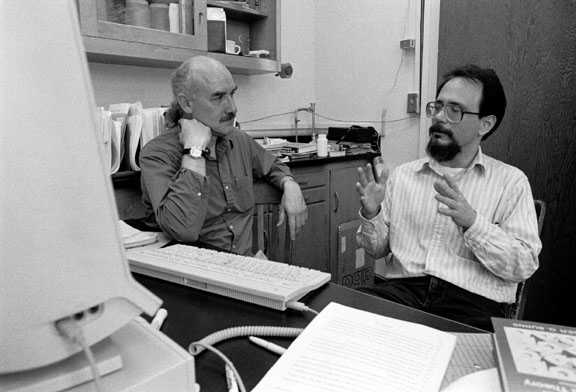The College of Agricultural and Life Sciences Quarterly",
Summer 1996, Vol. 15 (No. 1&2) pp. 1-2.
"Earth To Cyberspace"
Soil Science students
study via the Internet
WILL
BLEAM AND PHIL
BARAK are firmly grounded -- after all, they're soil scientists --
but they routinely send their students out to roam the electronic frontier.
Bleam and Barak use their department's computer lab to set up Internet-based
classwork ranging from electronic discussion groups to a "virtual textbook"
on the WorldWideWeb.
| SOILS ON THE WEB: In
cyberspace, the reading room is always open. |
 For
Will Bleam (left), e-mail groups offer a way to lead small-group discussion of
topics related to his class. Phil Barak (right) publishes a textbook on the web,
with illustrations, assigned readings and links to related subjects. The web
site gives him an affordable way to publish a full-color textbook. The best
part: he can update it at will. For
Will Bleam (left), e-mail groups offer a way to lead small-group discussion of
topics related to his class. Phil Barak (right) publishes a textbook on the web,
with illustrations, assigned readings and links to related subjects. The web
site gives him an affordable way to publish a full-color textbook. The best
part: he can update it at will.
Photo by
Wolfgang Hoffman |
Bleam teaches Soil Science 230 (Soil: Ecosystem & Resource) to about 70
students, mostly juniors and seniors. The course, designed for non-majors, is
cross-listed with Geography and the Institute for Environmental Studies.
Last semester, Bleam's students attended "virtual" discussion
sections using FirstClass software, which creates discussion groups via e-mail.
Each week Bleam posted a topic. Students logged in when convenient, discussed
the topic, and jointly wrote a summary at the end of the week. Bleam read and
commented on each summary.
The College doesn't use many teaching assistants, and the Web allows
professors to contact more students "directly," Bleam notes. He
estimates that the Web-linked class has pulled 90 percent of his students into
direct, albeit electronic, contact with the professor. In unwired classes, only
about 10 percent of his students contacted him directly, he says.
Bleam would like to see electronic discussion groups expanded, perhaps
someday replacing classroom discussion sections. He thinks the technology is
just as good as physical discussion sections in a classroom, and in some
respects better. Quieter students seem to feel more able to participate, there's
more scheduling flexibility, and the advantages on below-zero days are obvious.
New techniques and technologies usually contain a few lumps, and Bleam had
to fine-tune his methods to fit the teaching to the technology.
While Bleam uses the internet to set up electronic discussion groups, Phil
Barak has created an electronic textbook on the net's WorldWideWeb.
Barak teaches Soils 326 (Plant Nutrient Management), a requirement for soils
majors and an elective for horticulture and agronomy majors. Students have a
custom-tailored text at
/~barak/soilscience326/
-- a Web site created by Barak. These Web pages contain assigned readings plus,
in small print, digressions for students who want to learn more about a topic.
Barak's first Web "chapter," Essential Elements for Plant Growth,
opens with a link to the periodic table of elements. Clicking on an element
reveals information ranging from its date of discovery to its
electronegativities and ionization enthalpies. Further down the page, a
small-print link leads to a discussion of hydroponics. The next pages review
macro- and micronutrients, nutrient deficiencies, ionic charge, etc. Photos on
the following pages show plants with nutrient deficiencies.
Why a web site instead of handouts or chapter assignments in a textbook? "First
of all, the cost of textbooks with good color illustrations has become
prohibitive, and the process of creating such a textbook for a limited
readership is intimidating," Barak points out. "Besides, would a
publisher be interested in a new edition every year based on the author's
changing experience and every whim?"
Students routinely use the Web page, as well as e-mail dialog and on-line
problem sets. "Many have discovered that if they have questions about the
problem sets at odd hours, they can e-mail me from home or anywhere on campus
and get a reasonably prompt response. The informality of electronic
communications has also helped break down barriers in the dialog," he says.
Barak sees his students endorsing a new teaching paradigm.
"I feel that if I were to drop the use of electronically-delivered
messages, problem sets, supplemental texts, and class notes, my students would
revolt!" Barak says. "The students are watching the course web pages
for each new item as it is posted, so that the educational experience has broken
out of the lecture-plus-lab format."
WANT TO CHECK OUT A CYBER-TEXTBOOK?
/~barak/soilscience326/
---Bob Cooney,
Senior Editor, Ag&Life Sciences, AgJournalism, UW-Madison
This article originally appeared in "The
College of Agricultural and Life Sciences Quarterly", Summer 1996, Vol.
15 (No. 1&2) pp. 1-2.
CALS Quarterly features stories on
research, teaching and outreach programs conducted by the College of
Agricultural and Life Sciences, University of Wisconsin-Madison. Comments or
questions from readers are welcome. Send them to: CALS Quarterly, Department of
Agricultural Journalism, 440 Henry Mall, Madison, WI 53706.
Formatted for
the web on Aug 8, 1996.
 For
Will Bleam (left), e-mail groups offer a way to lead small-group discussion of
topics related to his class. Phil Barak (right) publishes a textbook on the web,
with illustrations, assigned readings and links to related subjects. The web
site gives him an affordable way to publish a full-color textbook. The best
part: he can update it at will.
For
Will Bleam (left), e-mail groups offer a way to lead small-group discussion of
topics related to his class. Phil Barak (right) publishes a textbook on the web,
with illustrations, assigned readings and links to related subjects. The web
site gives him an affordable way to publish a full-color textbook. The best
part: he can update it at will.